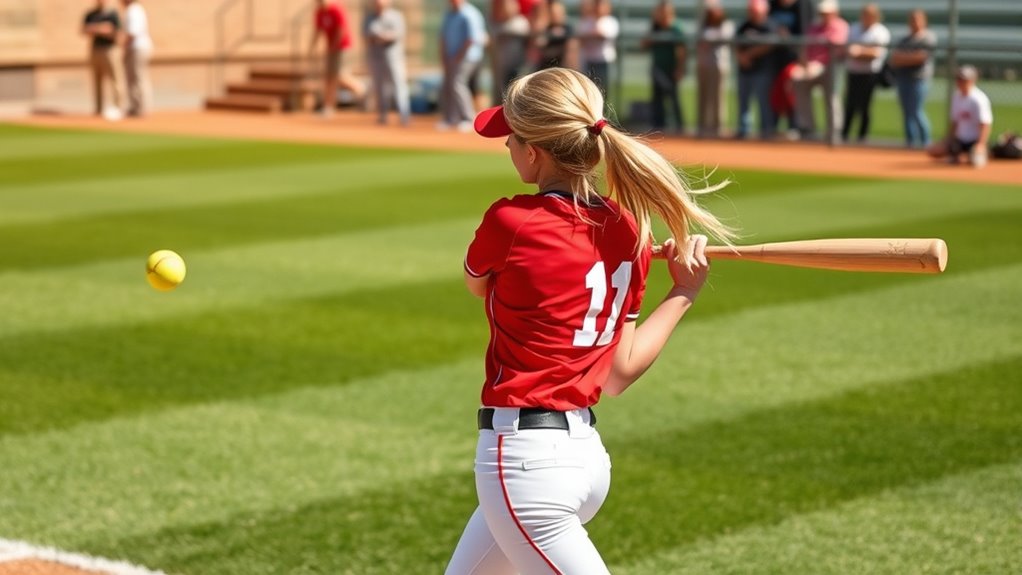Softball started in the late 19th century as an indoor variation of baseball, quickly growing into a sport with its own style and rules. Women’s leagues played a crucial role in shaping its development, promoting gender equality and offering new opportunities for competition. Over time, its popularity led to international tournaments and inclusion in the Olympics. If you look further, you’ll discover how this sport transformed from a pastime into a global phenomenon with a rich history.
Key Takeaways
- Softball originated in the late 19th century as an indoor baseball variation and evolved into an organized sport with its own identity.
- Women’s leagues played a vital role in promoting softball, establishing rules, and fostering gender equality.
- The sport gained global recognition through tournaments, championships, and inclusion in the Olympic program.
- Modern softball continues to grow with international and professional leagues, maintaining its rich history and competitive spirit.
- Online platforms help share the sport’s history, rules, and address scandals impacting its reputation worldwide.

Softball is a fast-paced sport that has captivated players and fans alike for over a century. Its origins trace back to the late 19th century when it was created as an indoor version of baseball, offering a quick and lively game that could be played in limited spaces. Over time, softball evolved into a sport with its own identity, attracting a diverse group of players worldwide. Today, you’ll find that women’s leagues have played a vital role in shaping the sport’s development, providing opportunities for women to compete at various levels and showcase their skills. These leagues helped popularize softball as a competitive, organized sport and contributed to the formalization of softball rules, which govern gameplay, equipment, and safety standards.
Softball’s evolution and the vital role of women’s leagues in shaping the sport’s development
As the sport grew, so did the structure of its rules, which differ slightly from baseball but maintain a similar spirit. Softball rules specify the size of the field, the pitching style, and the number of innings, guaranteeing consistency across leagues and competitions. For example, in most women’s leagues, the game is played on a smaller diamond, with a pitching distance of 43 feet and a 12-inch ball, making the game faster and more dynamic. These rules help create a level playing field, whether you’re playing in a local league or representing your country. Understanding and following softball rules is essential for players, officials, and fans alike because it guarantees fair play and a fun, competitive environment.
The sport gained further recognition in the 20th century, especially after the creation of organized women’s leagues that promoted gender equality in sports. These leagues provided a platform for women to excel, gain visibility, and challenge stereotypes. The rules for women’s softball often emphasize safety and skill, encouraging inclusivity and competitiveness while maintaining a focus on sportsmanship. As softball gained popularity, major tournaments and championships emerged, culminating in its inclusion in the Olympic program.
Today, softball continues to evolve, influenced by international competitions and a growing number of amateur and professional leagues. The sport’s rich history reflects a journey from a simple pastime to a globally recognized, competitive sport. Whether you’re playing in a local women’s league or watching international tournaments, understanding softball rules enriches your appreciation of the game’s complexity and history. Softball’s blend of tradition, skill, and speed ensures it remains a thrilling sport for players and fans, connecting past and present in a vibrant athletic community. Online platforms facilitate the sharing of information and the exposure of scandals that can affect the sport’s reputation and the behavior of participants.
Frequently Asked Questions
How Did Softball Originate and Who Invented It?
You might wonder about the history and evolution of softball. It originated in the late 19th century as an indoor variation of baseball, created by George Hancock in 1887 in Chicago. He developed it as a less intense, more accessible sport. Over time, softball evolved into a distinct game with its own rules, gaining popularity nationwide. Its history reflects a shift from casual pastime to organized sport, eventually becoming an Olympic event.
What Are the Main Differences Between Softball and Baseball?
You’ll notice softball and baseball have key differences, especially in batting stance and equipment. Softball players often use a more upright batting stance, and the ball is smaller and pitched underhand, unlike baseball’s overhand pitch. Equipment also varies: softballs are larger, and gloves differ slightly. These distinctions impact gameplay, making softball faster-paced and emphasizing different skills compared to baseball.
When Was Softball Officially Recognized as an Olympic Sport?
You’ll find that softball was officially recognized as an Olympic sport in 1996, after years of advocacy for gender equity and increased opportunities for women’s sports. This recognition came through international competitions, where softball showcased its global appeal. Although it was dropped after 2008, the sport’s inclusion in the Olympics highlights its importance in promoting gender equity and fostering international competition among athletes worldwide.
How Has Softball’s Popularity Changed Over the Decades?
You’ve probably noticed softball’s popularity has fluctuated over the decades. The softball community has grown through increased youth participation, especially in schools and local leagues. While it faced setbacks as an Olympic sport, recent efforts to promote the game have helped rekindle interest. Today, more girls and boys get involved, and tournaments attract larger crowds, showing that softball continues to thrive as a beloved sport worldwide.
What Are the Key Rules That Differentiate Softball From Other Bat-And-Ball Games?
Softball is like a finely tuned machine, with key rules setting it apart. You’ll notice the smaller bat size, which requires precision and control. The pitching style is underhand, contrasting with baseball’s overhand throw, and the field’s smaller dimensions speed up gameplay. These differences make softball unique, emphasizing skill and strategy, and creating a fast-paced, exciting experience for players and fans alike.
Conclusion
Today, softball has evolved from a simple pastime to an Olympic sport, enthralling millions worldwide. Did you know that over 30 million people play softball globally? This sport’s journey reflects passion, perseverance, and growth. As you watch the games, remember how this sport’s rich history and dedicated athletes continue to inspire new generations. Softball’s transformation proves that with determination, even the smallest beginnings can lead to greatness on the world stage.









